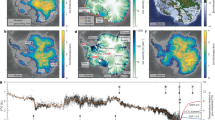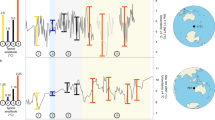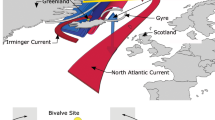Abstract
Proxy-based indicators of past climate change show that current global climate models systematically underestimate Holocene-epoch climate variability on centennial to multi-millennial timescales, with the mismatch increasing for longer periods1,2,3,4,5. Proposed explanations for the discrepancy include ocean–atmosphere coupling that is too weak in models6, insufficient energy cascades from smaller to larger spatial and temporal scales7, or that global climate models do not consider slow climate feedbacks related to the carbon cycle or interactions between ice sheets and climate4. Such interactions, however, are known to have strongly affected centennial- to orbital-scale climate variability during past glaciations8,9,10,11, and are likely to be important in future climate change12,13,14. Here we show that fluctuations in Antarctic Ice Sheet discharge caused by relatively small changes in subsurface ocean temperature can amplify multi-centennial climate variability regionally and globally, suggesting that a dynamic Antarctic Ice Sheet may have driven climate fluctuations during the Holocene. We analysed high-temporal-resolution records of iceberg-rafted debris derived from the Antarctic Ice Sheet, and performed both high-spatial-resolution ice-sheet modelling of the Antarctic Ice Sheet and multi-millennial global climate model simulations. Ice-sheet responses to decadal-scale ocean forcing appear to be less important, possibly indicating that the future response of the Antarctic Ice Sheet will be governed more by long-term anthropogenic warming combined with multi-centennial natural variability than by annual or decadal climate oscillations.
This is a preview of subscription content, access via your institution
Access options
Subscribe to this journal
Receive 51 print issues and online access
$199.00 per year
only $3.90 per issue
Buy this article
- Purchase on Springer Link
- Instant access to full article PDF
Prices may be subject to local taxes which are calculated during checkout




Similar content being viewed by others
Change history
04 January 2017
Citations to a new ref. 31 (Menviel, L. et al., 2011) were added; all references in the Methods were renumbered accordingly.
References
Collins, M. et al. A comparison of the variability of a climate model with paleotemperature estimates from a network of tree-ring densities. J. Clim. 15, 1497–1515 (2002)
Goosse, H. et al. Internal and forced climate variability during the last millennium: a model–data comparison using ensemble simulations. Quat. Sci. Rev. 24, 1345–1360 (2005)
Zorita, E. et al. European temperature records of the past five centuries based on documentary/instrumental information compared to climate simulations. Clim. Change 101, 143–168 (2010)
Lovejoy, S., Schertzer, D. & Varon, D. Do GCMs predict the climate...or macroweather? Earth Syst . Dyn. 4, 439–454 (2013)
Laepple, T. & Huybers, P. Ocean surface temperature variability: large model–data differences at decadal and longer periods. Proc. Natl Acad. Sci. USA 111, 16682–16687 (2014)
Cane, M. A. A role for the tropical Pacific. Science 282, 59–61 (1998)
Ferrari, R. & Wunsch, C. Ocean circulation kinetic energy: reservoirs, sources, and sinks. Annu. Rev. Fluid Mech. 41, 253–282 (2009)
Broecker, W. S. et al. J. Origin of the northern Atlantic’s Heinrich events. Clim. Dyn. 6, 265–273 (1992)
Clark, P. U., Alley, R. B. & Pollard, D. Northern Hemisphere ice-sheet influences on global climate change. Science 286, 1104–1111 (1999)
Ganopolski, A. & Rahmstorf, S. Rapid changes of glacial climate simulated in a coupled climate model. Nature 409, 153–158 (2001)
Liu, Z. et al. Transient simulation of last deglaciation with a new mechanism for Bölling-Alleröd warming. Science 325, 310–314 (2009)
Fogwill, C. J. et al. Sensitivity of the Southern Ocean to enhanced regional Antarctic Ice Sheet meltwater input. Earth’s Future 3, 317–329 (2015)
Green, J. A. M. & Schmittner, A. Climatic consequences of a Pine Island Glacier collapse. J. Clim. 28, 9221–9234 (2015)
Swingedouw, D. et al. On the reduced sensitivity of the Atlantic overturning to Greenland ice sheet melting in projections: a multi-model assessment. Clim. Dyn. 44, 3261–3279 (2015)
Weber, M. E. et al. Millennial-scale variability in Antarctic ice-sheet discharge during the last deglaciation. Nature 510, 134–138 (2014)
The RAISED Consortium et al. A community-based geological reconstruction of Antarctic Ice Sheet deglaciation since the Last Glacial Maximum. Quat. Sci. Rev. 100, 1–9 (2014)
Bueler, E. & Brown, J. Shallow shelf approximation as a ‘sliding law’ in a thermomechanically coupled ice sheet model. J. Geophys. Res. 114, F03008 (2009)
Golledge, N. R. et al. Antarctic contribution to meltwater pulse 1A from reduced Southern Ocean overturning. Nat. Commun. 5, 5107 (2014)
Golledge, N. R. et al. The multi-millennial Antarctic commitment to future sea-level rise. Nature 526, 421–425 (2015)
Whitehouse, P. L., Bentley, M. J. & Le Brocq, A. M. A deglacial model for Antarctica: geological constraints and glaciological modelling as a basis for a new model of Antarctic glacial isostatic adjustment. Quat. Sci. Rev. 32, 1–24 (2012)
Cuzzone, J. K. et al. Final deglaciation of the Scandinavian Ice Sheet and implications for the Holocene global sea-level budget. Earth Planet. Sci. Lett. 448, 34–41 (2016)
Weaver, A. J. et al. The UVic earth system climate model: model description, climatology, and applications to past, present and future climates. Atmosphere–Ocean 39, 361–428 (2001)
Menviel, L. et al. Climate and biogeochemical response to a rapid melting of the West Antarctic Ice Sheet during interglacials and implications for future climate. Paleoceanography 25, PA4231 (2010)
Crowley, T. J. North Atlantic deep water cools the Southern Hemisphere. Paleoceanography 7, 489–497 (1992)
Delworth, T. L. & Zeng, F. Multicentennial variability of the Atlantic meridional overturning circulation and its climatic influence in a 4000 year simulation of the GFDL CM2.1 climate model. Geophys. Res. Lett. 39, L13702 (2012)
Menary, M. et al. A multimodel comparison of centennial Atlantic meridional overturning circulation variability. Clim. Dyn. 38, 2377–2388 (2012)
Abram, N. J. Early onset of industrial-era warming across the oceans and continents. Nature 536, 411–418 (2016)
PAGES 2k-PMIP3 group. Continental-scale temperature variability in PMIP3 simulations and PAGES 2k regional temperature reconstructions over the past millennium. Clim. Past 11, 1673–1699 (2015)
Liu, Y. et al. Ocean-driven thinning enhances iceberg calving and retreat of Antarctic ice shelves. Proc. Natl Acad. Sci. USA 112, 3263–3268 (2015)
Zunz, V., Goosse, H. & Massonnet, F. How does internal variability influence the ability of CMIP5 models to reproduce the recent trend in Southern Ocean sea ice extent? Cryosphere 7, 451–468 (2013)
Menviel, L., Timmermann, A., Elison Timm, O. & Mouchet, A. Deconstructing the Last Glacial Termination: the role of millennial and orbital-scale forcings. Quat. Sci. Rev. 30, 1155–1172 (2011).
Bakker, P. et al. Iceberg-rafted debris stack of sediment cores MD07-3133 and MD07-3134, 0-10 ka, PANGAEA. https://doi.pangaea.de/10.1594/PANGAEA.865349 (2016)
Fischer, H. et al. Reconstruction of millennial changes in dust emission, transport and regional sea ice coverage using the deep EPICA ice cores fromthe Atlantic and Indian Ocean sector of Antarctica. Earth Planet. Sci. Lett. 260, 340–354 (2007)
Sprenk, D. et al. Southern Ocean bioproductivity during the last glacial cycle—new detection method and decadal-scale insight from the Scotia Sea. Geol. Soc. Lond. Spec. Publ. 381, 245–261 (2013)
Liu, Z. et al. Transient simulation of last deglaciation with a new mechanism for Bølling-Allerød warming. Science 325, 310–314 (2009)
Acknowledgements
This work was supported by a grant from the National Oceanographic and Atmospheric Administration (award number NA15OAR4310239 to P.B. and A.S.), the Antarctic Glaciology Program of the National Science Foundation (grant number 1043517 to P.U.C.), the Royal Society of New Zealand’s Marsden Fund (grant number VUW1203 to N.R.G.) and the Deutsche Forschungsgemeinschaft (DFG grant number We2039/8-1 to M.E.W.). We thank L. Menviel for providing us with the LOVECLIM-based Southern Ocean subsurface temperature data. Development of PISM is supported by NASA grants NNX13AM16G and NNX13AK27G.
Author information
Authors and Affiliations
Contributions
P.B. and A.S. designed the study. P.B. performed the UVic climate model simulations and analysed the results. M.E.W. constructed the IBRD stack. N.R.G. performed the PISM ice-sheet simulations. P.B. and P.U.C. wrote the paper. All authors discussed the results and commented on the manuscript.
Corresponding author
Ethics declarations
Competing interests
The authors declare no competing financial interests.
Additional information
Reviewer Information
Nature thanks P. Valdes and the other anonymous reviewer(s) for their contribution to the peer review of this work.
Extended data figures and tables
Extended Data Figure 1 Simulated sensitivity of major climate variables to specifics of applied AIS discharge forcing.
Comparison of simulated AABW export strength, AMOC strength and Southern Hemisphere (SH) sea-ice area for the experiment in which all AIS discharge is distributed uniformly over the Southern Ocean south of 60° S (FWF-SO), over the Southern Ocean around the WAIS (south of 60° S and between 150° E and 360° E; FWF-WAIS) or to the Southern Ocean south of 60° S, but including the associated total heat flux (FWF-HEAT) in addition to the AIS discharge forcing. For comparison the results are also presented for the control (CTRL) simulation.
Extended Data Figure 2 Correlations between forcings and respones.
Correlations between key variables as a function of lead-lag (years) and smoothing period length (years; running mean). Black lines indicate lead-lag for which optimal correlation is found at the given smoothing period. a, AIS discharge (FWF) is correlated (approximately 0.5) with LOVECLIM-based subsurface temperature forcing (‘Temp’) at very short lags. b, c, f, Strong correlations are found between AIS discharge and AABW (b), AIS discharge and Southern Ocean surface temperatures (‘SOsurf’; c) and between AABW and AMOC changes (f). d, e, Weakly correlated are Southern Ocean surface and subsurface temperature (‘SOsubsurf’; d), and subsurface temperature forcing (‘Temp’) and the resulting subsurface temperature (e), pointing towards nonlinearities in the involved feedback loops. Note that the correlations between FWF and AABW and between AABW and AMOC are positive because a strengthening of AABW means more negative values.
Extended Data Figure 3 Deep ocean response to AIS variability.
Temperature anomalies (colour scale) and meridional streamfunction anomalies (contours, in units of Sv) for periods of weak AABW export. a, Southern Ocean; b, Atlantic Ocean; c, Pacific and Indian Oceans. Values for periods of strong AABW are nearly identical albeit with reversed signs. Depicted values are averages over all three experiments. See Methods for definition of the AABW periods.
Extended Data Figure 4 Sensitivity of simulated climate variability to the magnitude of imposed AIS discharge variations.
For different AIS discharge variability forcings (2σ) the resulting variability is presented for: a, AABW export strength; b, AMOC strength; c, Northern Hemisphere surface-air temperatures (‘NH SAT’); and d, Southern Hemisphere surface-air temperatures (‘SH SAT’). Linear regressions are provided (green lines) together with value of the slope and goodness-of-fit (R2). The red crosses give the results for the reference FWF-SO simulation.
Extended Data Figure 5 Simulated Holocene Southern Ocean subsurface temperature variability in the LOVECLIM-based forcing and the Trace21k simulation.
a, b, LOVECLIM and Trace21k (CCSM3) Southern Ocean subsurface temperature anomalies as time series (a) and in frequency space (b). Trace21k results are only given for the part of the simulation referring to 4.5 kyr ago to the present, in order to avoid any impact by remnants of Northern Hemisphere deglaciation.
Source data
Rights and permissions
About this article
Cite this article
Bakker, P., Clark, P., Golledge, N. et al. Centennial-scale Holocene climate variations amplified by Antarctic Ice Sheet discharge. Nature 541, 72–76 (2017). https://doi.org/10.1038/nature20582
Received:
Accepted:
Published:
Issue Date:
DOI: https://doi.org/10.1038/nature20582
This article is cited by
-
Historical information sheds new light on the intensification of flooding in the Central Mediterranean
Scientific Reports (2023)
-
Radiocarbon evidence for the stability of polar ocean overturning during the Holocene
Nature Geoscience (2023)
-
Transient vegetation degradation reinforced rapid climate change (RCC) events during the Holocene
npj Climate and Atmospheric Science (2023)
-
Regional but not global temperature variability underestimated by climate models at supradecadal timescales
Nature Geoscience (2023)
-
High-latitude precipitation as a driver of multicentennial variability of the AMOC in a climate model of intermediate complexity
Climate Dynamics (2023)
Comments
By submitting a comment you agree to abide by our Terms and Community Guidelines. If you find something abusive or that does not comply with our terms or guidelines please flag it as inappropriate.



